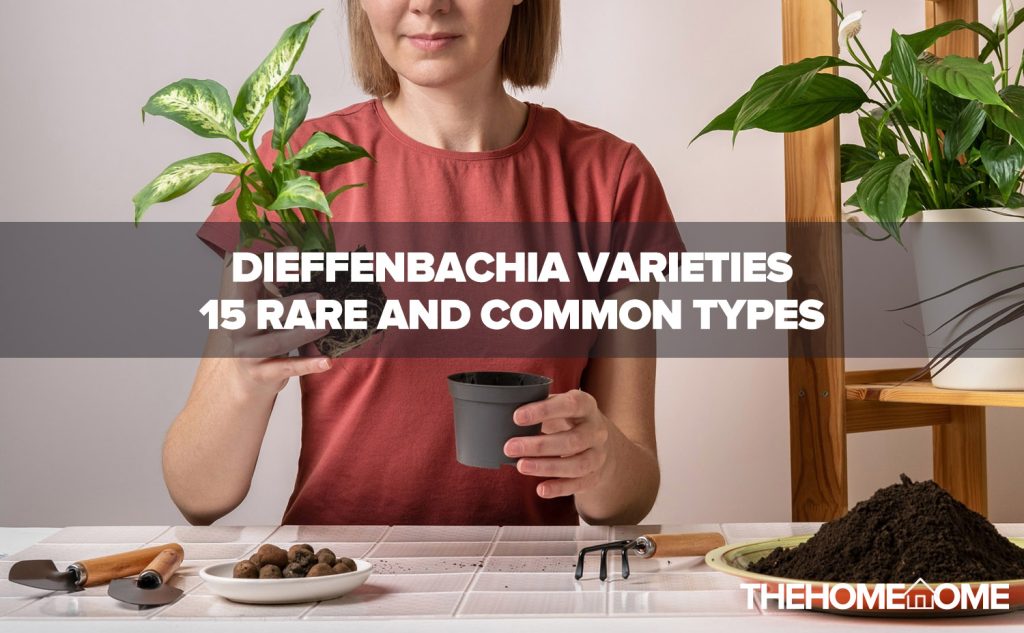The Dieffenbachia species belongs to the class of exotic houseplants with varied foliage designs and colors, little wonder it is a popular option for houseplant growers and interior decorators.
The houseplant is used as an ornamental plant for aesthetic effects in homes. The popular houseplant is an easy propagation and maintenance plant that requires inexpensive growth needs to survive.
The Dieffenbachia plant is sure to thrive when provided with moderate watering, proper lighting, appropriate temperature and humidity, organic soil, and a suitable container that matches the size of the plant.
This houseplant is a perfect option for beginners considering its easy maintenance and drought tolerance in particular. The common problems associated with this plant are under-watering, overwatering, poor lighting, and inappropriate temperatures.
These could be averted when the grower is equipped with the information needed for the propagation journey.
Dieffenbachia is one species every houseplant grower should consider, so we have provided a list of the most striking and common Dieffenbachia plants for you, alongside maintenance tips.
Dieffenbachia Plant Basic Information and Care
This is a brief plant profile of the Dieffenbachia species and tips that would aid a thriving and stress-free propagation journey.
| Scientific name | Dieffenbachia spp. |
| Native Origin | Tropical America, Argentina, Mexico |
| Light | Medium-light |
| Watering | Moderate watering |
| Temperature | 62°F-80°F |
| Toxicity | Toxic to pets and humans |
| Food | Balanced house plant fertilizer |
| Humidity | Low humidity |
| Mature size in height | 8 ft. |
| Mature size in width | 3 ft. |
| Foliage color | Green, yellow, cream, and white |
| Common Plant issues | Root rot, drooping leaves, fading leaves, pest infestations from aphids and mealybugs |
The following tips are sure to help you in your propagation journey.
- Never allow the soil to completely dry out before watering. Check the soil with the tip of your fingers before watering to gauge the amount of water needed.
- Keep away from heating vents, rafts, and air conditioners.
- Do not place the plant in poorly lit environments. Ensure they are kept in areas where they can receive bright indirect sunlight.
- Regularly mist the leaves of the Dieffenbachia plant.
- In a case of overwatering, stay off watering for a while till the soil is almost dried. If root rot has occurred, repot the plant to give it a better chance of surviving.
- Always look out for changes in foliage color and appearance.
- Make use of gloves while tending to the plant as sap could irritate the skin.
- Regularly mist the leaves by using a spray bottle.
- Ensure your Dieffenbachia plant is kept out of reach from kids and pets as it is highly toxic.
- Always sterilize pruning equipment to prevent the spread of pest infestations.
15 Dieffenbachia Varieties You Can Grow Today
If the Dieffenbachia plant is next on your to-plant list, we have provided 9 of the most attractive and common varieties you can start your propagation journey.
1. Dieffenbachia Honeydew
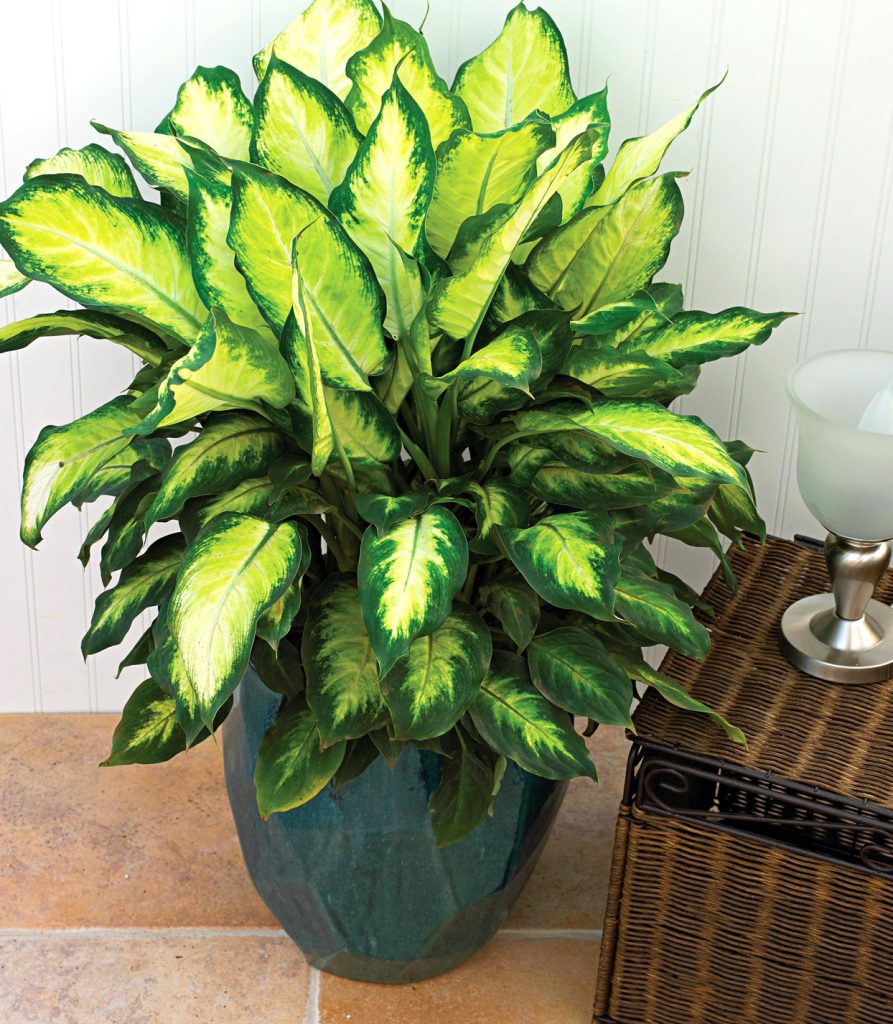
Dieffenbachia Honeydew is one of the most striking and colorful species. Its wide leaves are beautifully lined in different hues of green and white. If you need a houseplant that can take away the dryness of your home, the Dieffenbachia is a good option.
Amongst other Dieffenbachia varieties, it is easily recognizable for its brightly colored lush leaves.
Alongside being easy to propagate the plant, the Dieffenbachia plant is relatively affordable and can be purchased from nearby nurseries or online ornamental plant stores. To get the best off this striking houseplant, make use of a white and beautifully shaped container, although this depends on what you fancy.
The Dieffenbachia plant would thrive if it is provided with moderate watering, good lighting, organic soil, a well-drilled container, and an appropriate temperature.
You can maintain the beautiful appearance of this plant by regularly misting the leaves, placing them in attractive containers, and keeping them away from pets and kids. In addition, looking out for pests’ infestations and combating them early upon detection protects the appearance of the plant.
2. Dieffenbachia Maculata
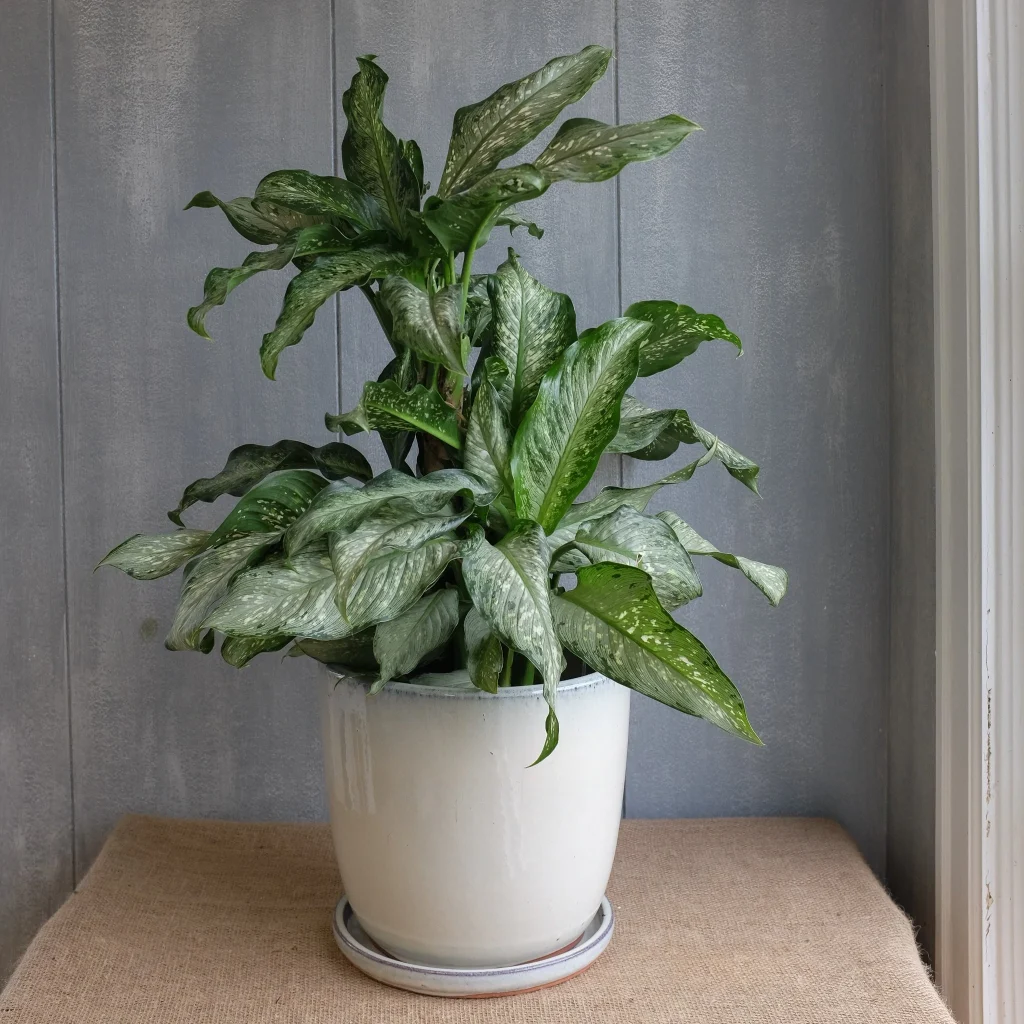
The Dieffenbachia maculata plant is also known as ‘Dumb Cane’ or ‘Tropical Tiki’. This plant has large decorative leaves in dark and light shades of green and caring for it is quite simple. It prefers a temperature between 60-80 degrees F, cold drafts and sudden temperature changes have to be avoided for its healthy growth.
This variety has lush and stylish green foliage and it is one of the popular types of Dieffenbachia. It makes an amazing indoor plant and prefers bright indirect sunlight.
It usually remains at 3 feet so you don’t have to worry about it growing out of proportion indoors. It does have multiple stems and a shrubbery growth. It can also boast of dark green leaves that are edged in bright gold foliage.
3. Dieffenbachia Seguin
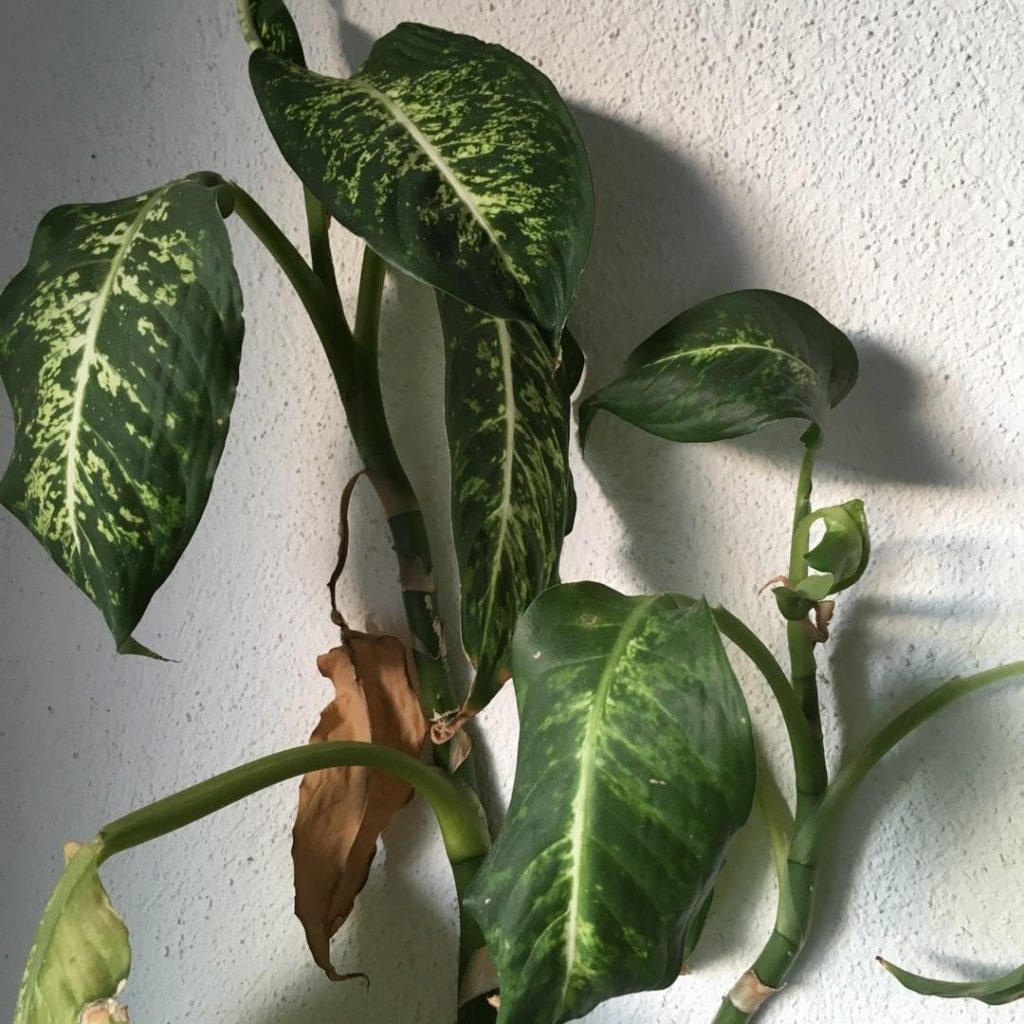
Another striking species of the Dieffenbachia lot is the Dieffenbachia Seguine. It is commonly referred to as the Tuft root and has its origin in tropical America. Dieffenbachia is commonly found in Southern Mexico Brazil and Puerto Rico.
This variety has veined line markings and the markings are a mixture of emerald and cream.
When mature, the plant can grow up to 8 inches in height and 3 inches in width. They are easy to propagate plants, so it is a common option for beginners. Providing their basic growth requirement in an adequate and appropriate measure ensures the Dieffenbachia Seguine plant thrives.
These growth needs are 5 to 6 hours of bright indirect sunlight, proper soil mix, moist soil, regular misting, and appropriate temperature and humidity levels. The Dieffenbachia Seguine is toxic to both pets and humans, so they should be properly and cautiously kept away from their reach.
In cases of ingestion, go to the clinic or the Veterinary doctor immediately as the case may be.
4. Dieffenbachia Carina
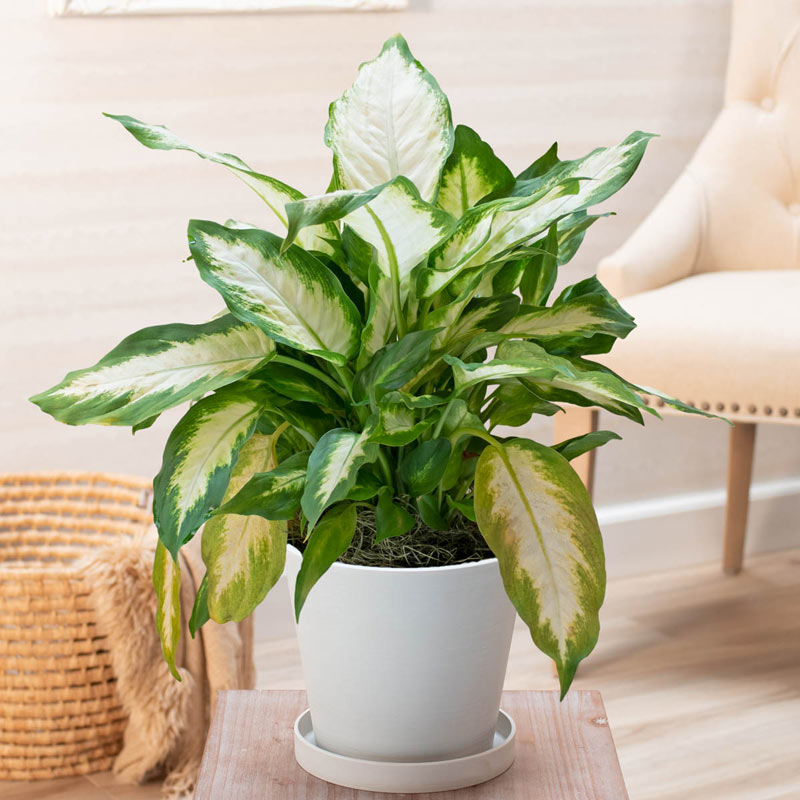
The Dieffenbachia Carina belongs to the class of the most attractive foliage designs and has its origin in Mexico and Argentina. The wide leaves of the Dieffenbachia plant have splotches and dotted markings of green and cream.
Its attractive feature contributes to interior decorations and is commonly used for an aesthetic effect.
Being a drought-tolerant plant, the Dieffenbachia Carina is a good option if you have a busy schedule that should not enough reason to outrightly neglect the plant. The Dieffenbachia Carina can be grown both indoors and outdoors. When grown indoors, the appropriate temperature of the plant should be kept around 15 °C- 30 °C.
The temperature of your home can be measured using a glass temperature or free mobile applications that can detect a room’s temperature. This plant is common in online ornamental stores if it is scarce in nearby nurseries.
They are low-maintenance plants that would grow with the provision of good lighting, medium watering, and appropriate containers that match the plant size, organic soil, and warm temperatures.
5. Dieffenbachia Tropic Snow
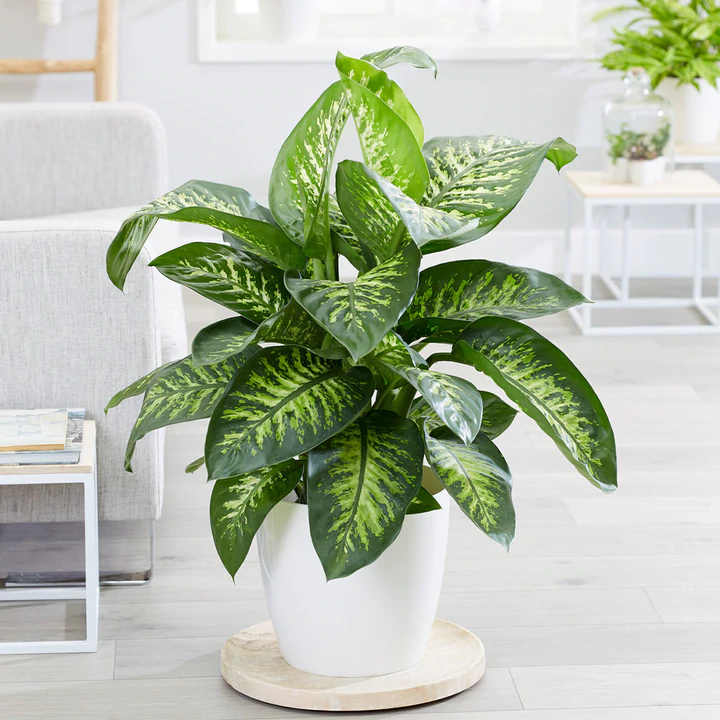
This is another fascinating variety of Dieffenbachia that also makes a great indoor plant. It can also be called dumb cane and it does look similar to the tropical tiki plant however this has large oblong green leaves which are variegated with white or gold patterns which are really beautiful.
Dieffenbachia Tropic Snow is one of the largest varieties or you can trim it regularly to maintain a certain size indoors. Tropic snow is best watered weekly to check when the top of the soil is dry before you water it.
This is one of the easiest houseplants to go for however you have to place it where it gets medium levels of indirect light. The chilling cold temperatures might not freeze the plant but it can cause some injuries, it thrives between 60 to 80 degrees F.
6. Dieffenbachia Camouflage
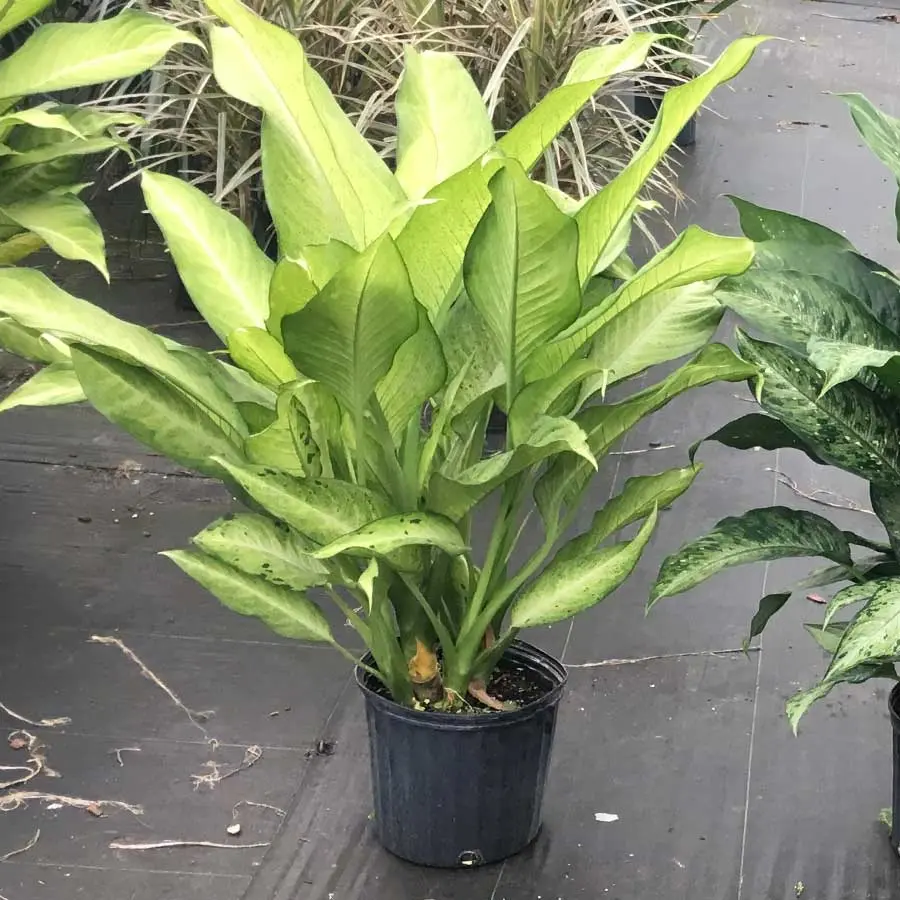
The Dieffenbachia Camouflage plant has oval-shaped leaves with slightly wavy edges. The foliage design is uniquely patterned with deep veined lines. The leaves are demarcated with light and bright-colored lines in the middle. In addition, the Dieffenbachia Camouflage has dark splotches around the leaves.
Different varieties of the Dieffenbachia camouflage have different hues of green.
Dieffenbachia when properly nurtured can grow up to 45 inches in height together with wide leaves. This means this variety must be grown in suitable containers that can match the size of the Dieffenbachia plant.
An undersized pot can cause problems for your Dieffenbachia Camouflage. This variety should receive about 4 to 5 hours of bright indirect sunlight daily, especially when grown indoors.
Placing them at the window besides ensures they get adequate light from the sun but if this proves insufficient, adopt the use of artificial light. The eye-catching plant’s appearance can be complemented with brightly colored and artistically sculptured containers.
7. Dieffenbachia Sterling
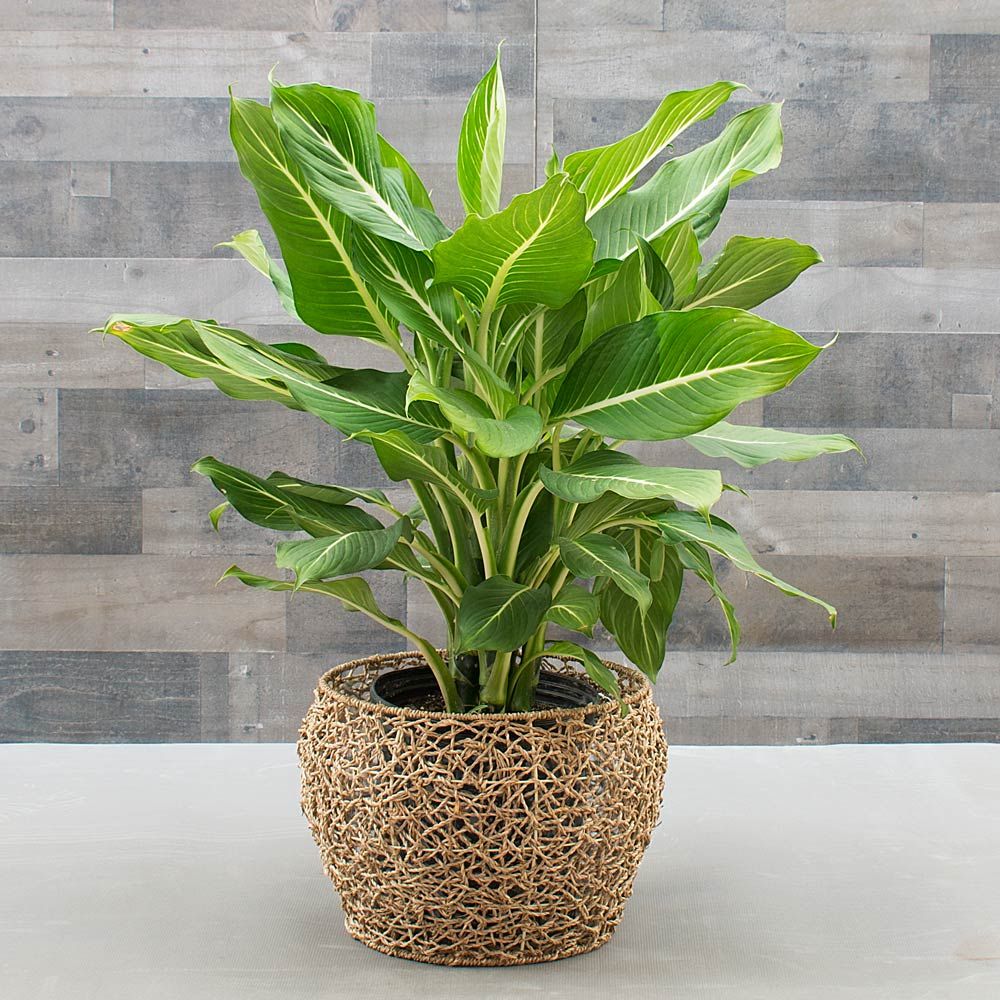
Here is another dieffenbachia plant variety you will love to add to your houseplant collections. Dieffenbachia sterling has really stunning bold white midribs that stand out in contrast to other varieties of dieffenbachia. It is a cool indoor plant and thrives in diffused sunlight or partial shade.
It should be watered regularly but allow the soil to dry between watering or you can water when the top soil is dry. This variety looks sticking all year round and has lovely pattern foliage as well.
Dieffenbachia sterling doe well in temperatures between 60 and 80 degrees. However, it is a slow-growing plant but will reward you with large gorgeous foliage and contrasting white veins.
8. Dieffenbachia Panther

The Dieffenbachia Panther is an exotic and striking plant not just for its foliage size but also for its attractive foliage design. The Dieffenbachia plant is a thin-oval-shaped plant with green edges and white splotched and dotted markings. Some varieties of this plant come in either white or cream splotches.
When properly tended, the plant has an alluring vigor that can brighten up the aesthetic outlook of your home.
The Dieffenbachia plant can be grown indoors and outdoors; it can be grown in nursery beds to be transferred to a container at a later point. At a mature age, this variety can grow up to 3 ft. in height and even 3 ft. in width.
This plant should be watered persistently but not up to the point where the soil gets soggy as this can be a bad state for your roots. The appropriate soil for this soil is organic soil which drains easily. Regularly lookout for pests and keep this plant away from pets and kids.
9. Dieffenbachia Delilah
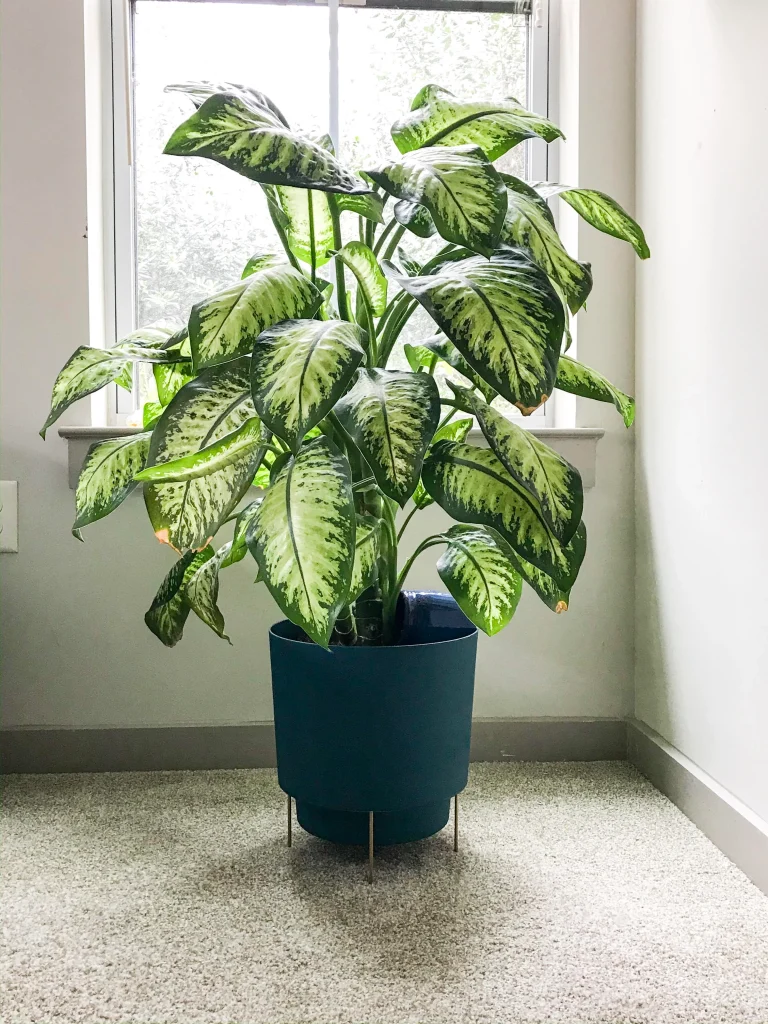
Dieffenbachia Delilah is an unusual variety, it has big pointy leaves that have greenish whitish patches in the center with unusual edges as well. It can also grow quite large which makes it a more wonderful houseplant. This plant is easy to care for and hardy and drought with little to no care.
It has large decorative leaves hence it can be planted in your outdoor and indoor garden, the leaves are in dark and light shades of green. Dieffenbachia Delilah is another cultivar of dumb cane but it happens to be a rare variety.
It is a super rare houseplant but worth growing if you do come across it. It thrives best on getting lots of water so ensure not to leave the soil dry for too long.
Its leaves are 12 to 14 inches long and the leaf color can range from bright to dark. It will do best in moderate sunlight and it should be regularly fertilized as well.
10. Dieffenbachia Tropic Marianne
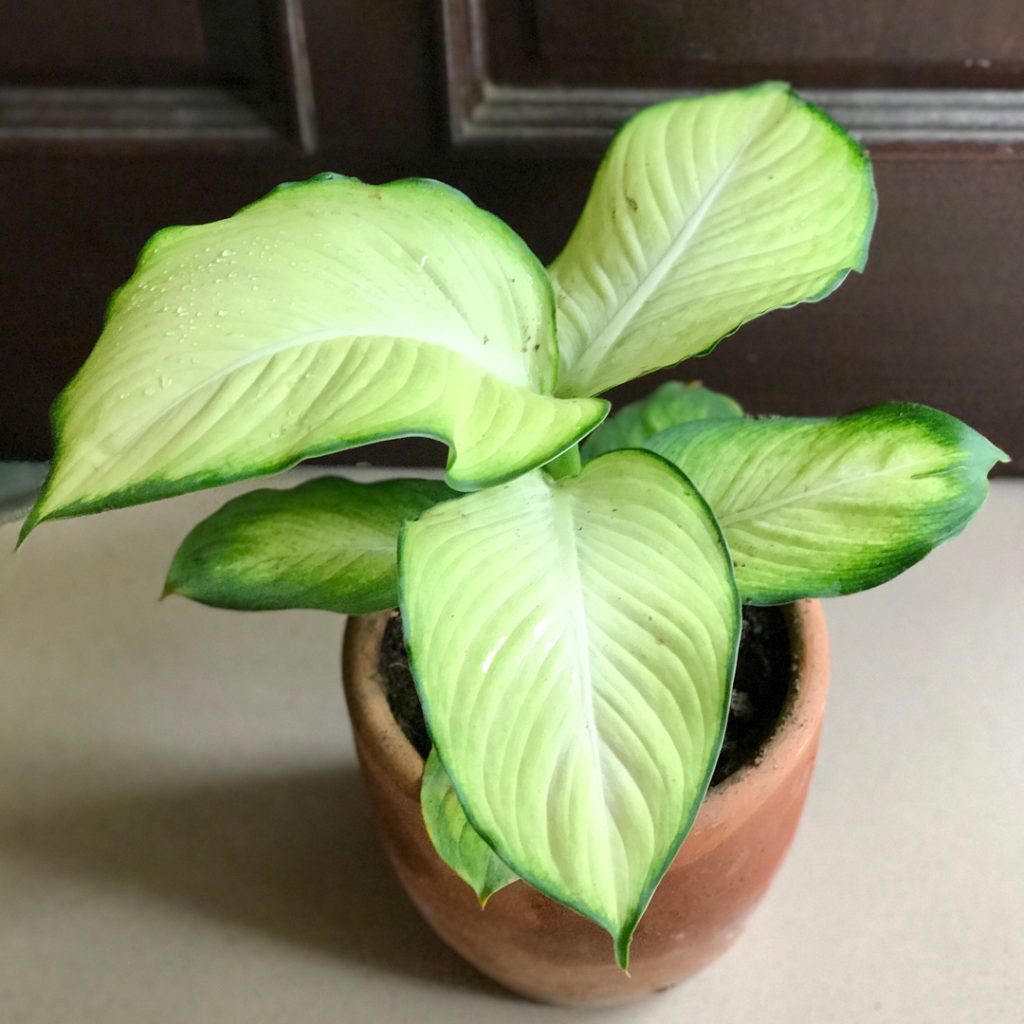
Amongst other varieties, the Dieffenbachia Tropic Marianne is referred to as the show-stopping species because of its broad and marbled combination and green and cream. Some varieties come in emerald and cream. This variety sure lives up to the term “striking”. Placing them in brightly colored containers would your home not so small good.
Asides from placing them in containers around the home, you could place them in dangle baskets, hanging shelves, and other conspicuous locations that would ensure the plant complements your home or working space.
This variety thrives when it is watered properly and growers must be cautious about ensuring every aspect of the plant is adequately watered because the broad leaves may deprive other parts of receiving sufficient watering needed to thrive and this can lead to issues for your Tropic Marianne plant.
Ensure this plant receives bright indirect sunlight for about 5 hours daily. Placing them in poorly lit areas can cause the Dieffenbachia Tropic Marianne to lose its vibrant color and vigor.
11. Dieffenbachia White Etna
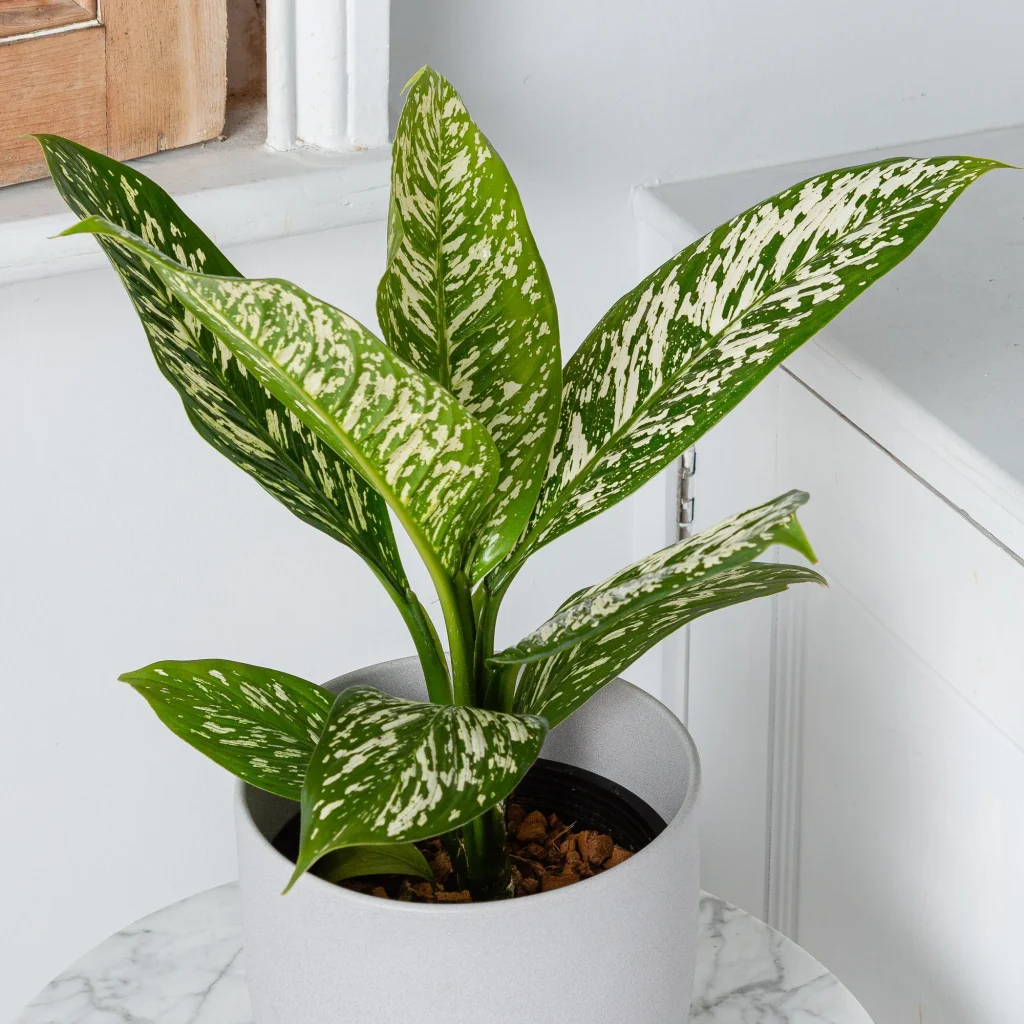
Unlike other varieties that have an unequal amount of colorful splotches and markings, the Dieffenbachia White Etna has an even spread of green and white speckles across the leaf making it a sight to behold in any home, whether grown indoors or outdoors.
Usually, this variety grows from one stalk with broad and brightly colored leaves.
At a mature age, the White Etna can grow up to 35 inches. This easy propagation and maintenance require moderate watering, medium lighting, organic soil, balanced fertilizer, good potting, and an appropriate temperature to survive.
While tending to this plant, it is advisable to wear gloves as the pap can be irritable to your skin, and you can be at risk of ingestion.
This variety must be regularly misted to keep dust off the leaves, wade off pests, and improve the humidity level of the plant. The Dieffenbachia plant is toxic and should be kept out of the reach of both kids and pets.
12. Dieffenbachia Rebecca
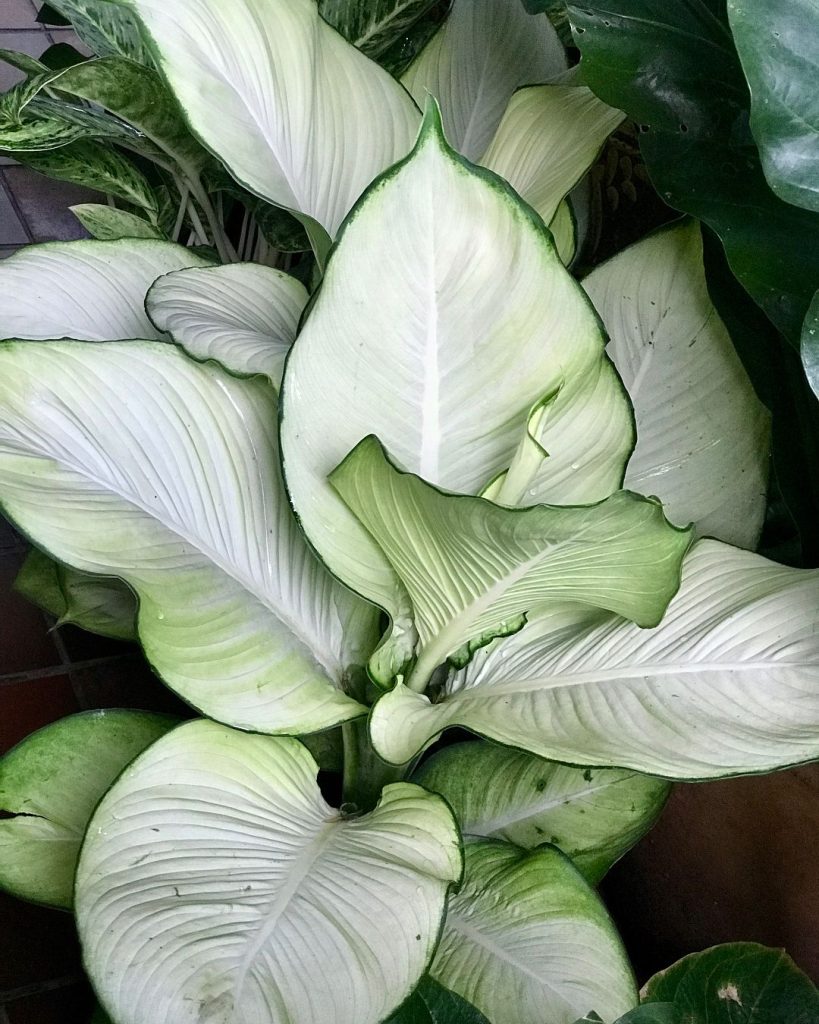
This is a variety of dieffenbachia plants that really stands out among others. Dieffenbachia Rebecca is a rare variety and it is commonly known as Rebecca’s Jewel, the plant’s color shows best in medium to high heat but you have to avoid full sun.
It has variegated foliage with matching bright bold white colors and this can change depending on how it’s being cared for. The lower leaves tend to turn yellow in dim light.
This plant prefers soil that is consistently moist and ensures not to water too often so you don’t overwater it. Water it only when the top soil is dry but if it is placed in an area with lower light, it can dry further than the top.
Rebecca’s Jewel has the characteristics of near white foliage which makes it stands out from other varieties. It is a compact variety and a low maintenance plant too.
13. Dieffenbachia Aurora
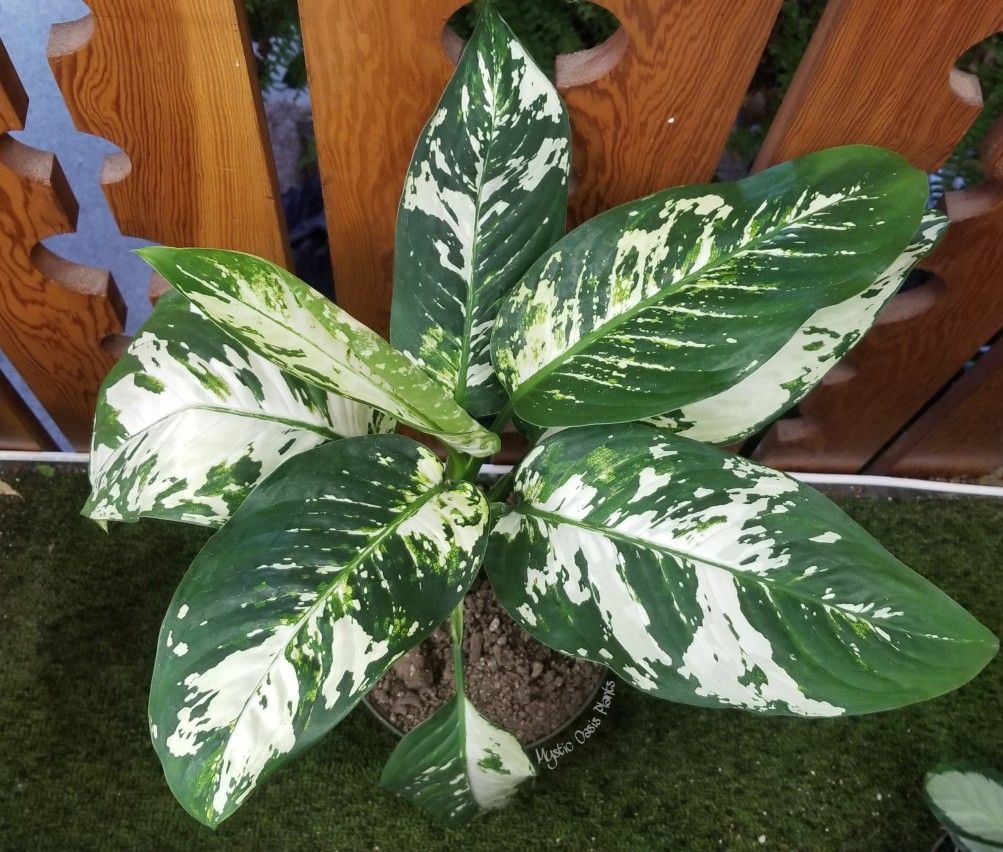
Dieffenbachia Aurora is another beautiful variety with an uneven spread of white patches, splotches, and dotted markings across the leaf. The Dieffenbachia Aurora is a fast grower and is a low-maintenance plant. This plant has its origin in the Caribbean and South America. They can grow up to 3 ft. in height and 2 ft. in width.
Although it is mostly grown as a gardening plant, it has gained popularity as an indoor houseplant for its attractive foliage color and design.
The Dieffenbachia Aurora is a suitable option for beginners. Growers are advised to adequately water this plant with the endpoint of moist soil. Placing this variety in a poorly lit environment is bad news as the foliage’s vigor and color are at risk of being damaged.
They thrive in areas where they can receive bright indirect light daily; artificial light can come in handy if natural light is insufficient. If this plant starts drooping, the grower should look out for its lighting needs.
14. Dieffenbachia Daguensis
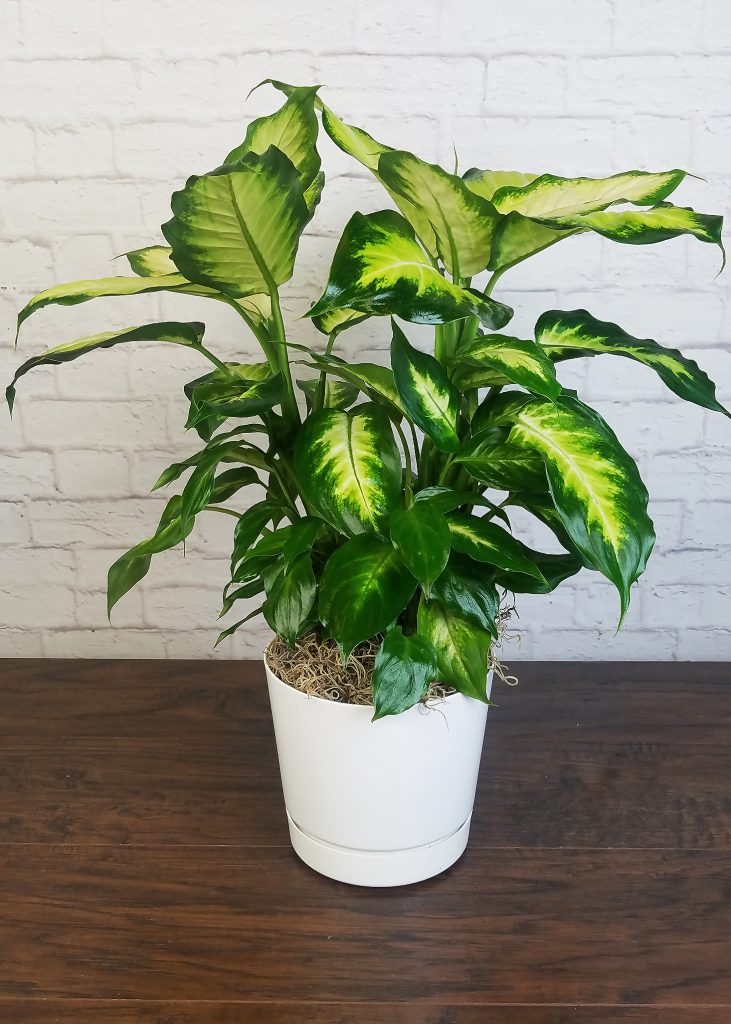
The Dieffenbachia daguensis is an unusual variety marked with a dark or speckled portion on the surface of its leaves. An amazing feature of this plant is the only side of this plant would be splotched or speckled and is often in a different color other than the prominent foliage color.
This variety should be grown in a suitable container that would match the size of the plant.
The Dieffenbachia daguensis is best appreciated when it is kept in a brightly colored container. This plant should be kept away from drafts and heating vents as exposure to such can damage the foliage appearance of the plant. It is best to use neither ceramic nor aluminum containers for potting as elements could seep into the soil, damaging it.
Make use of well-drilled containers for proper drainage of water. The Dieffenbachia daguensis should be placed in an area where it can receive medium sunlight. When grown outdoors, they should be placed in shaded areas to prevent exposure to harsh weather conditions.
15. Dieffenbachia Star Bright
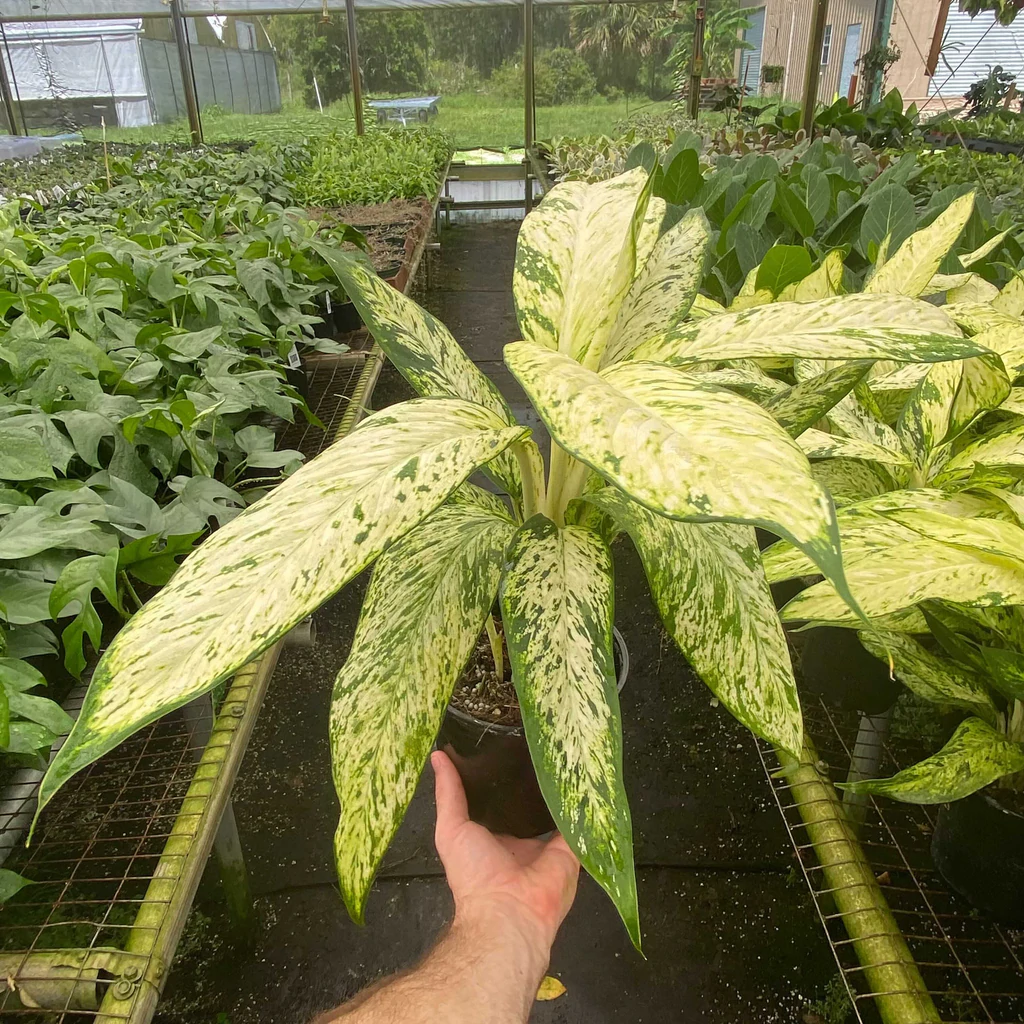
Dieffenbachia star bright is ideal for adding color to your home and garden. It produces tough leathery foliage and has tall upright stems and green and cream-colored leaves that are easy to care for. It is a really attractive houseplant and tolerates full shade but thrives in partial shade.
This variety grows best indoors, especially in places like the bathroom or you can have it plated in shady spots in your garden. It prefers a warm humid position that is far away from drought and extreme cold.
It is well suited as a houseplant as the outdoor light can be too much for it. Every of its leaf patterns is really stunning, the speckled and freckled cream and light green are bright in contrast to the lime green and dark green varieties.
Final Note
Dieffenbachia is an attractive lot that would brighten the outlook of any home regardless of how drab it may be.
All varieties of the Dieffenbachia species have striking and unique foliage designs that can suit your fancy. You can try propagating more than one variety if you want a full mass of Dieffenbachias in your home. Be creative with their placements and make use of dangle baskets or hanging shelves.
More houseplant guides:
- Peperomia Varieties: 12 Types Of Peperomia Plants
- 6 Common & Rare Spider Plant Varieties To Propagate Today
- Tradescantia Varieties: 10 Common And Rare Types
- Coneflower Varieties: 9 Common And Rare Types Of Cone Flowers
- Croton Plant Varieties, Problems, FAQs (Complete Guide)
- Pilea Varieties: 11 Types Of Pilea Plants To Grow Today
- Scindapsus Varieties: 6 Types Of Scindapsus Plants To Grow Today

